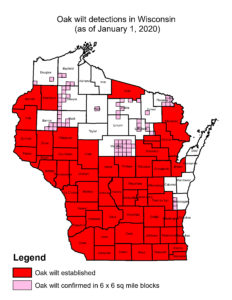By forest health specialists Paul Cigan, Hayward, paul.cigan@wisconsin.gov, 715-416-4920 and Linda Williams, Woodruff, linda.williams@wisconsin.gov, 920-360-0665
Oak wilt has been found for the first time in Forest County and several new northern townships in 2019. These previously undocumented infections were detected using a combination of ground surveys, forester and landowner reports and aerial survey flights. This deadly fungal disease of red oaks has now been confirmed in 65 of Wisconsin’s 72 counties.

Oak wilt detection map as of January 1, 2020.
The new county detection was confirmed after wood samples were taken from two red oak trees in the Town of Lincoln, just north of Lake Lucerne. One sample tree died in 2018 and another was actively wilting at the time of sampling. The samples were then processed in the DNR Forest Health lab where they tested positive for oak wilt.
New township detections in previously confirmed counties include Madge in Washburn County and Namakagon in Bayfield County.
Oak wilt is commonly found in the southern two-thirds of the state and has been creeping northward in recent years. It was found in Oneida County for the first time in 2010. Two years later, oak wilt was confirmed in Lincoln, Sawyer and Vilas counties followed by Rusk County in 2013, Washburn County in 2014, and Price County in 2015. Oak wilt has been confirmed in all Wisconsin counties except Ashland, Calumet, Door, Iron, Kewaunee, Manitowoc and Taylor.
The highest risk period for overland spread of oak wilt in Wisconsin is April – July. Winter is the safest time to cut and prune oaks, so now through March is a good time to conduct forestry and shade tree care activities that could injure oaks and invite the sap-feeding beetles that transmit oak wilt from infected to healthy trees.
More information about oak wilt, including signs and symptoms of infection, disease prevention and control can be found on the DNR oak wilt webpage. To discuss seasonal oak harvesting considerations, contact your local forest health specialist. Homeowners seeking yard tree care should contact a certified arborist through the Wisconsin Arborist Association at www.waa-isa.org.
